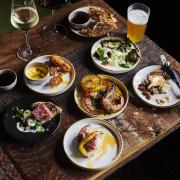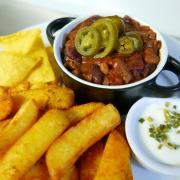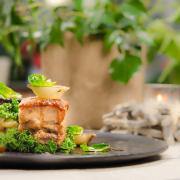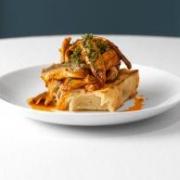They’re responsible for keeping us magnificently well-fed throughout the year at their acclaimed restaurants, but how do Kent’s top chefs feed their own nearest and dearest at this most special time of the year – and what advice do they have to offer to the rest of us when it comes to Christmas catering without tears? We find out from a trio of experts.

Will Devlin, chef-owner of Green Michelin-starred restaurant, The Small Holding, Kilndown
“Whether we’re hosting or at my mum’s in Horsmonden for Christmas, I tend to do the cooking – I enjoy it! While we’ll keep it traditional, my wife does insist on Yorkshire puddings, which proved a bit controversial when she first introduced the idea when we’d just started dating. My mum’s a traditionalist so her take was, ‘but you only have them with roast beef’. My wife’s response: ‘Are they always delicious? Yes! So why wouldn’t you want to eat them whenever possible?’ Now we always have them with turkey – though, that said, last year I did cook a rib of beef too and I’ve served venison in the past – it’s always nice to have an alternative, I think.
My advice for hassle-free Christmas cooking? Don’t do too much – especially in the current climate, don’t buy tons of stuff, don’t make loads of stuff, don’t eat loads of stuff. Instead, buy less but buy better – and from local butchers and greengrocers wherever possible. Pre-prep everything as far as you can: peel and blanch your veggies the night before, have your giblet stock ready for gravy. Then you should be able to relax as far as possible – for many of us, it’s the most special feast we’ll have in the year, so you need to be able to enjoy it. And make sure everyone helps with the clearing up afterwards!”

Will’s loin of venison with chestnuts, bacon and cabbage
Venison is a hugely underrated meat. It’s wild, plentiful, sustainable and delicious cooked fast and pink or low and slow. This is a warming wintery dish, but it is celebratory enough to grace the festive table.
Serves 2 for a main course
Ingredients
2 x 200g venison pieces, trimmed of any sinew
300g winter cabbage such as savoy or cavolo nero, washed and shredded
100g chestnuts, ether vac packed or roasted and deshelled weight
100g smoked belly bacon
4 cloves garlic, peeled and lightly crushed
3 sprigs thyme
500ml beef or chicken stock
250ml red wine
150g unsalted butter
Method
Prepare the sauce by simmering the stock and wine until reduced by three quarters and intensely flavoured. Keep warm.
Season the venison pieces well with salt and pepper and sear in a medium hot pan with a little rapeseed oil, turning often for an even colour all over. Add 50g butter, two lightly crushed garlic cloves and a sprig of thyme. Keep spooning the foaming brown butter over the venison as it pan-roasts, for about four minutes. At this stage it should feel firm to touch and will be medium rare on the inside and caramelised and golden on the outside. Keep warm and leave to rest.
In a small frying pan, add a drizzle of rapeseed oil and the bacon and fry until the fat renders and is crispy. Add the chestnuts and coat in the bacon fat until starting to caramelise and add the reduced stock and wine liquid to deglaze the pan. Stir and keep warm.
In a small saucepan, with a lid, add 100g of butter and the remaining cloves of garlic and thyme. Stir until melted and you can smell the garlic and add the finely chopped cabbage. Stir and replace the lid, moving the pan every so often while the cabbage cooks in its own steam. Remove the garlic cloves and thyme and season with salt.
To serve, slice each venison loin into three or four pieces and plate with the cabbage and bacon and chestnut sauce. Good served with mashed potato and swede and a glass of the same wine used in the sauce.

Alex Yates, Head chef at Bowleys Restaurant at The Plough, Trotttiscliffe
‘On Christmas Day, we have a delightful tradition of opening our doors to locals. We welcome everyone for three hours of festive drinks and canapés for the community to enjoy.
Supporting local suppliers is essential for me. We always get our Christmas turkey from our trusted local butcher, Glover's in Longfield. It's a tradition we've maintained for years, and the quality is exceptional. Additionally, I like to incorporate seasonal produce from nearby farms to ensure the freshest ingredients in our dishes at home and in our restaurant. In our family, there's always a debate about red cabbage. I personally love it and insist on making it; it brings a burst of colour and a unique flavour to the table – my recipe is inspired by the great Raymond Blanc’s.’
My top tips for Christmas cooking at home? Don't underestimate the importance of a good quality stock for your gravy and sauces – it can elevate the entire meal. Lastly, if you're roasting meat, invest in a meat thermometer to ensure it's cooked to perfection, not overcooked.’

Alex’s Festive red cabbage
Serves 8 as an accompanying vegetable – and the flavours improve if it’s made in advance. Keeps for up to four days in the fridge.
2kg red cabbage
30 Juniper berries
15g sea salt
40g butter
2 cinnamon sticks
4 star anise
250ml orange juice
50ml Port
250ml water
150ml Balsamic vinegar
200g redcurrant jelly
Zest of 1 orange
400g Granny Smith apples, grated
Method
Grind the juniper berries with the salt in a pestle and mortar.
Mix the sliced cabbage with the salt and juniper and leave for half an hour for flavours to mingle.
Melt the butter in a large pan with a lid over a low heat and add the red cabbage. Let it cook for about five minutes, stirring occasionally.
Add all the other ingredients and stir.
Pop a lid on the pan and simmer over a very gentle heat for about an hour and a half, checking every now and then that it’s not sticking.
Adjust the seasoning to taste.

Jed Wrobel, Head Chef, Water Lane, Hawkhurst
There’s a lot going on at Christmas and it can be obviously quite stressful, especially for the cook or the person ‘in charge’ of hosting. The best thing to do if this role falls to you is to prep and delegate, and to make simple, get-ahead-of-yourself dishes that can sit happily in the fridge until needed. Seafood and smoked fish is always popular during this time of year. I love scallops [see recipe below] and I’m big fan of the less usual smoked conger eel - I source mine from Rock-a-Nore Fisheries in Hastings. I serve it on blinis as a nibble with drinks, or on a large fried potato rosti with creamed horseradish and diced beetroot lightly pickled in red wine vinegar. It’s lovely as canapé or a starter served with cranberry fizz cocktails, simply a few tablespoons of cranberry juice topped up with the Kent sparkling wine of your choice.

Jed’s Scallop, celeriac purée, apple and pepper dulse
Serves 8
A little seafood decadence doesn’t go amiss over the festive period. Serve these delicious scallops in their shells piled high on your favourite platter. They can be made ahead of guests arriving. Keep them in the fridge after stage 7, below, then blast them in a hot oven ahead of serving. Pepper dulse adds a peppery salty tang to the scallops. If you can’t source it from your fishmonger (though Waitrose has it in its Cook’s Ingredients section), try a sprinkle of seaweed salt or even crispy fried bacon or chorizo.
Ingredients
24 scallops (in their shells, ask your local fishmonger to gut and clean them)
1 medium celeriac (peeled and diced in 2cm pieces)
50g butter
20ml light olive oil
150ml double cream
3 red eating apples (cut into matchstick size pieces)
1 lemon, juiced
50g pepper dulse [see introduction]
For the celeriac purée:
Melt the butter in a large pan with the olive oil. Add the celeriac with a large pinch of salt, cover with scrunched-up baking paper, and put the lid on.
Cook gently for 20 minutes, stirring regularly, until the celeriac is very soft and starting to collapse. If it starts to stick, add a splash of water to the pan.
In a separate pan bring the double cream to the boil. Combine the cream and cooked celeriac into a blender and process until smooth.
To cook the scallops:
Preheat oven to 240oC.
Prep the apple into matchsticks, adding drops of lemon juice to prevent discolouring.
Rinse the dulse, if fresh, then roughly chop and brush the scallops with a little oil and season.
Spoon a tablespoon of the celeriac purée onto the bottom of each reserved scallop shell and bed the seasoned scallop meat into the purée.
Roast in the oven 10 mins.
To serve, garnish with the matchstick apple pieces and a sprinkle of pepper dulse.




























